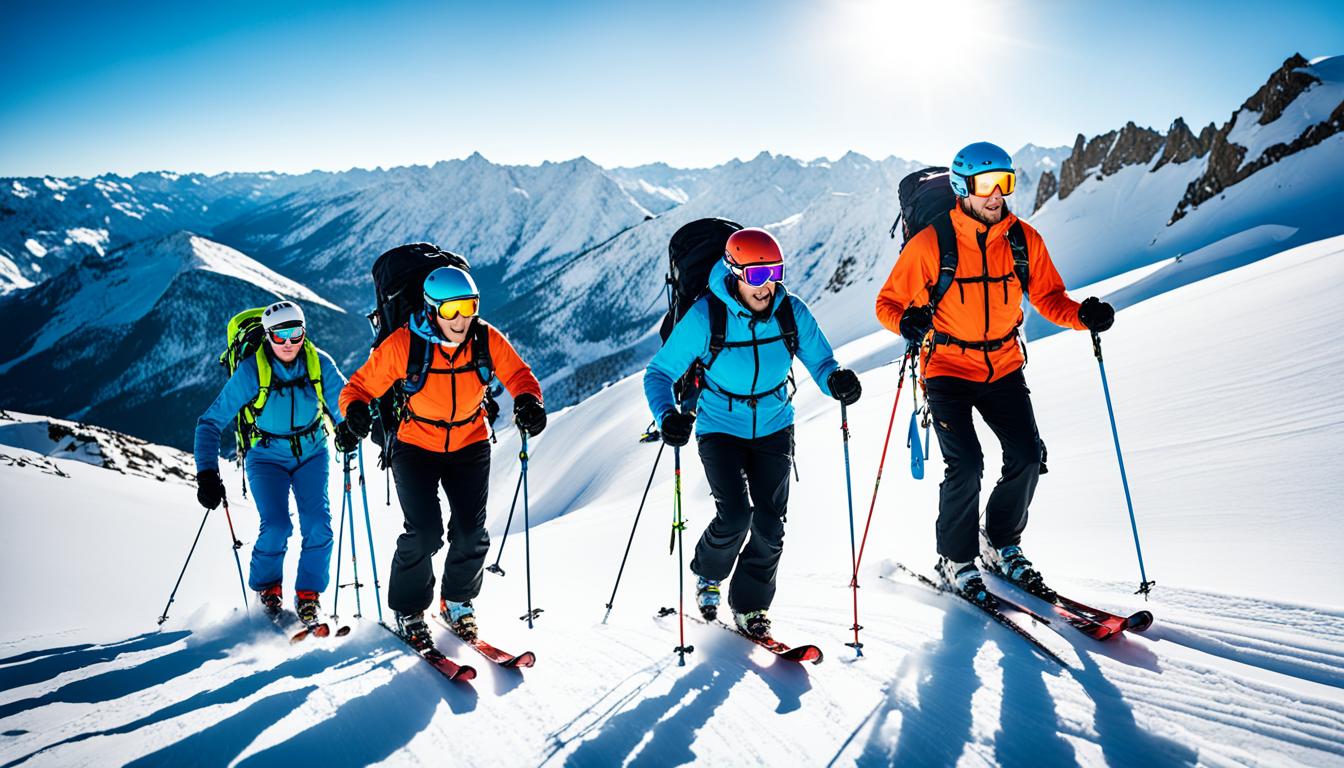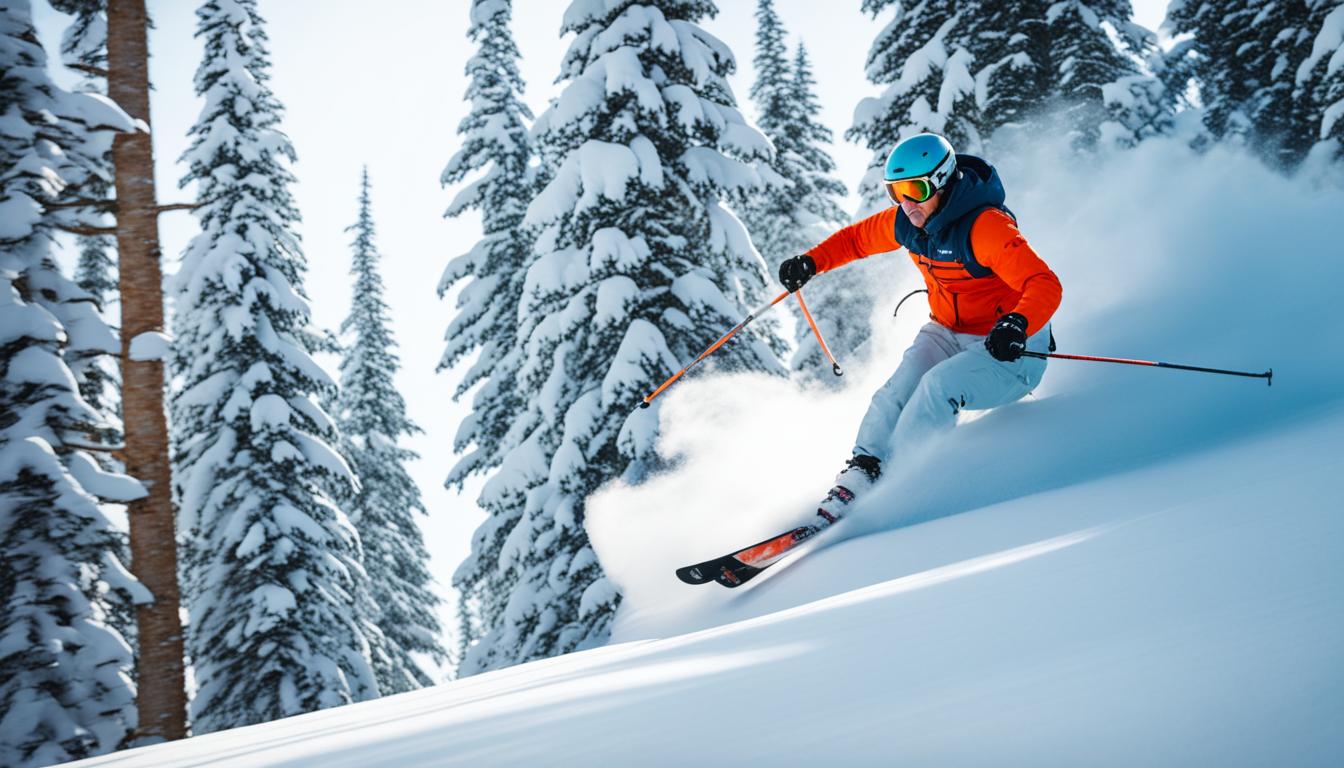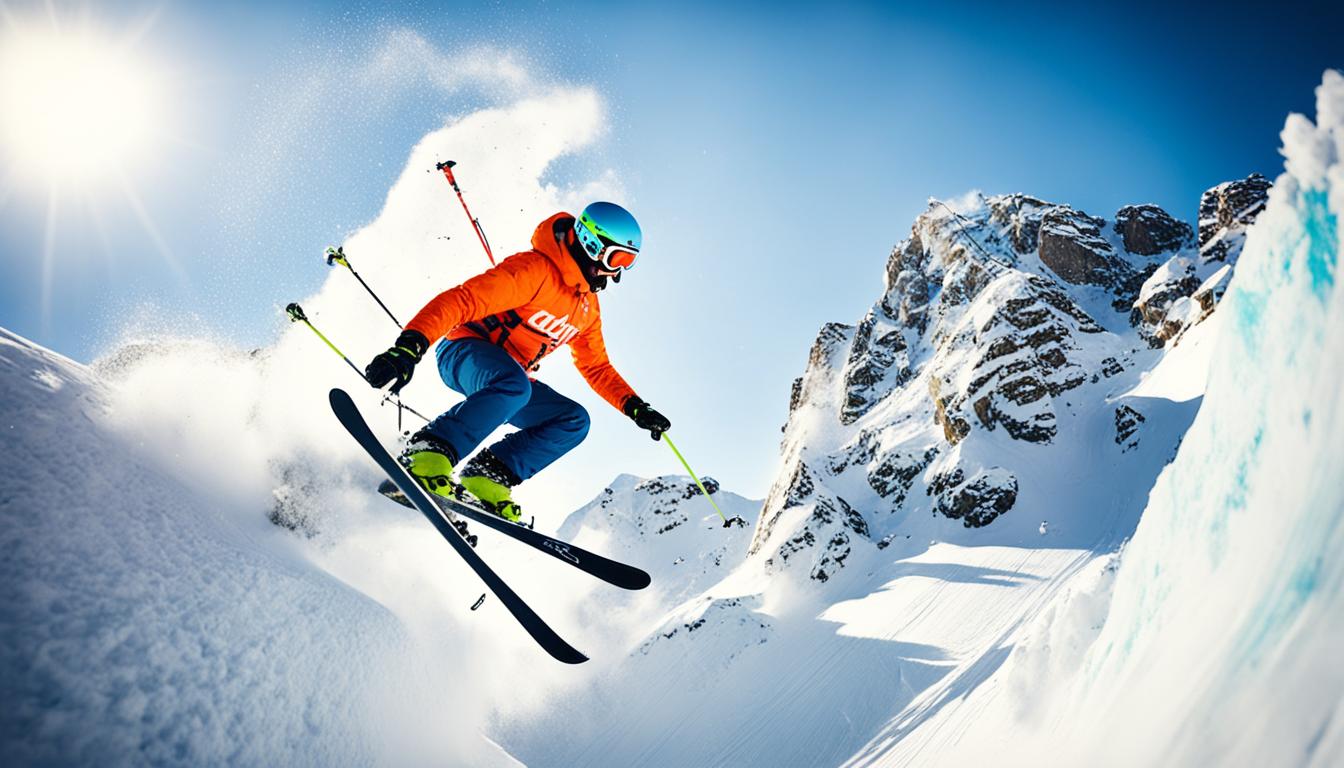If you’re an advanced skier with a passion for capturing stunning ski photos, you’re in the right place. In this article, we’ll share some valuable tips to elevate your ski photography skills and help you capture professional-quality shots that showcase the excitement and thrill of skiing.
As an advanced skier, you already have a deep understanding of the sport and the dynamics involved. Now, it’s time to translate that knowledge into mesmerizing images that tell a story. Let’s dive into some essential tips that will take your ski photography to the next level.
Key Takeaways:
- Experiment with different angles and perspectives
- Be mindful of exposure in bright snowy environments
- Pay attention to the position of the sun to maximize contrast and textures
- Utilize fast shutter speeds to freeze the action
- Consider the background for clean and uncluttered photos
Get Creative with Angles and Perspectives
When it comes to ski photography, one of the most important elements is finding unique angles and perspectives to capture compelling images that stand out from the rest. By experimenting with different viewpoints, you can add drama and interest to your ski photos.
One technique to try is getting down low on the ground. By shooting from a lower angle, you can create a sense of power and grandeur, making the skier appear larger than life. This perspective also allows you to highlight the details of the snow, enhancing the overall texture and depth of your photos.
On the other hand, finding high angles can offer a fresh perspective that adds a new dimension to your images. By positioning yourself above the skier, you can capture the scene from a bird’s-eye view, showcasing the vastness of the slopes and the skier’s movements. This angle can create a sense of awe and adventure, immersing the viewer in the excitement of skiing.
When photographing skiing tricks, it’s crucial to anticipate the moment of action and position yourself to capture the skier’s pose at its most dynamic. By doing so, you can freeze the movement and capture the skill and athleticism of the skier.
Remember, the key is to be creative and experiment with different angles and perspectives. Don’t be afraid to try new things and think outside the box. By pushing the boundaries of traditional ski photography, you can create visually engaging images that truly capture the spirit and energy of the sport.
Mastering Exposure in Snowy Environments
When it comes to ski photography, shooting in bright white snowy scenes can present a unique set of challenges. The camera’s exposure meter often tends to underexpose the photos, resulting in dull and gray images. To overcome this, it’s essential to master exposure in snowy environments.
“Adjusting the exposure compensation function on your camera can make a world of difference in capturing well-lit and vibrant ski photos.”
The exposure compensation function allows you to manually adjust the exposure settings to compensate for the bright snowy scenes. By increasing the exposure compensation dial to +1 or +2, you can produce brighter images that bring out the true colors of the snow. This adjustment prevents the snow from appearing dull and dreary, ensuring that your ski photos reflect the beauty of the surroundings.
Mastering exposure in snowy environments is crucial for achieving the desired visual impact in your ski photography. It allows you to accurately capture the details, textures, and contrasts in the snow, making your photos more engaging and dynamic.
“Proper exposure not only enhances the aesthetics of your ski photos but also contributes to the storytelling aspect, showcasing the energy and excitement of the skier.”
Capturing the Perfect Exposure
Here are some tips to help you capture the perfect exposure in snowy scenes:
- Use the histogram: Check the histogram on your camera’s screen to ensure that the exposure is well-balanced. The histogram provides a graphical representation of the brightness levels in your image and helps you avoid overexposure or underexposure.
- Take test shots: Experiment with different exposure compensation settings to find the perfect balance. Take test shots and review them on your camera’s screen to determine the ideal exposure compensation value.
- Shoot in RAW: Shooting in RAW format gives you greater flexibility in post-processing. You can make further adjustments to the exposure and recover any lost details in the snow during editing.
- Utilize spot metering: Spot metering focuses the exposure on a specific area of the scene, allowing you to accurately meter the snow. Aim for a well-exposed area of the snow to ensure the overall exposure is balanced.
By implementing these techniques, you can master exposure in snowy environments and capture ski photos that truly showcase the beauty and excitement of the sport.
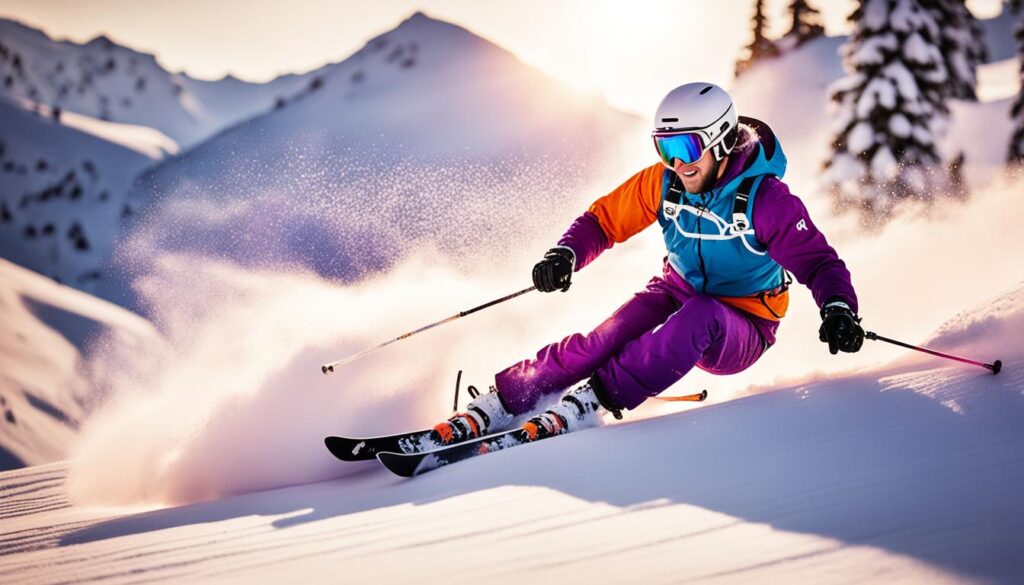
| Advantages of Mastering Exposure in Snowy Environments | Challenges of Shooting in Snowy Scenes |
|---|---|
| 1. Vibrant and well-lit ski photos | 1. Underexposed images |
| 2. Accurate representation of colors | 2. Gray and dull snow |
| 3. Enhanced textures and contrasts | 3. Difficulty in achieving proper exposure |
Harnessing the Power of Light and Shadows
Understanding how light and shadows can enhance your ski photos is essential for capturing stunning images. While shooting during the ‘golden hour’ can provide ideal lighting with softer tones and colorful skies, it may not always be possible on the slopes. In such cases, we can work with the position of the sun to create interesting light and shadow patterns on the snow. By keeping the sun to our side, we can reveal the undulations and textures in the snow, adding contrast and depth to our photos.
When the sunlight hits the slopes from an angle, it creates beautiful long shadows that add drama and interest to our ski photos. These elongated shadows emphasize the dimensions and contours of the terrain, enhancing the overall visual impact. By capturing the play of light and shadows on the snow, we can create captivating compositions that draw the viewer’s attention.
By utilizing sunlight in ski photos, we can also highlight the skier and their movements. The interplay of light and shadows can accentuate the skier’s form and create dynamic compositions. When the sun is low in the sky, the long shadows cast by the skier can capture the energy and action of the moment, adding a sense of excitement to the photograph. This technique is particularly effective when capturing jumps, tricks, or fast descents.
Remember to pay attention to the direction and quality of light when using sunlight in ski photography. The angle and intensity of the sunlight can significantly affect the mood and atmosphere of the image. Experiment with different positions in relation to the sun to achieve the desired effect in your photos.
In summary, harnessing the power of light and shadows is essential for creating captivating ski photos. By working with the position of the sun and utilizing the interplay between light and shadows, we can elevate the visual impact of our images. So, the next time you’re out on the slopes, make use of the natural lighting available to capture stunning ski photos.
Freezing the Action with Fast Shutter Speeds
When it comes to ski photography, capturing action shots with precision and clarity is crucial. To achieve this, we need to understand the importance of using fast shutter speeds. By setting the right shutter speed, generally around 1/1000 of a second or faster, we can freeze the action and prevent any unwanted motion blur.
There are two modes on your camera that can help you achieve these fast shutter speeds: sports mode and shutter priority mode. Sports mode is a pre-programmed setting specifically designed to capture fast-moving subjects, such as skiers on the slopes. Shutter priority mode, on the other hand, allows you to manually set the shutter speed while the camera adjusts other settings accordingly.
By using either of these modes, you can ensure that the skier’s movements are captured with clarity and precision, allowing you to showcase the exhilarating moments of skiing. It’s important to note that different lighting conditions and the speed at which the skier is moving may require slight adjustments to the shutter speed, so don’t be afraid to experiment and find the optimal setting for your specific situation.
Remember, the key to freezing the action lies in using fast shutter speeds. So, the next time you’re out on the slopes, make sure to utilize these ski photography techniques to capture those breathtaking action shots that truly encapsulate the thrill of skiing.
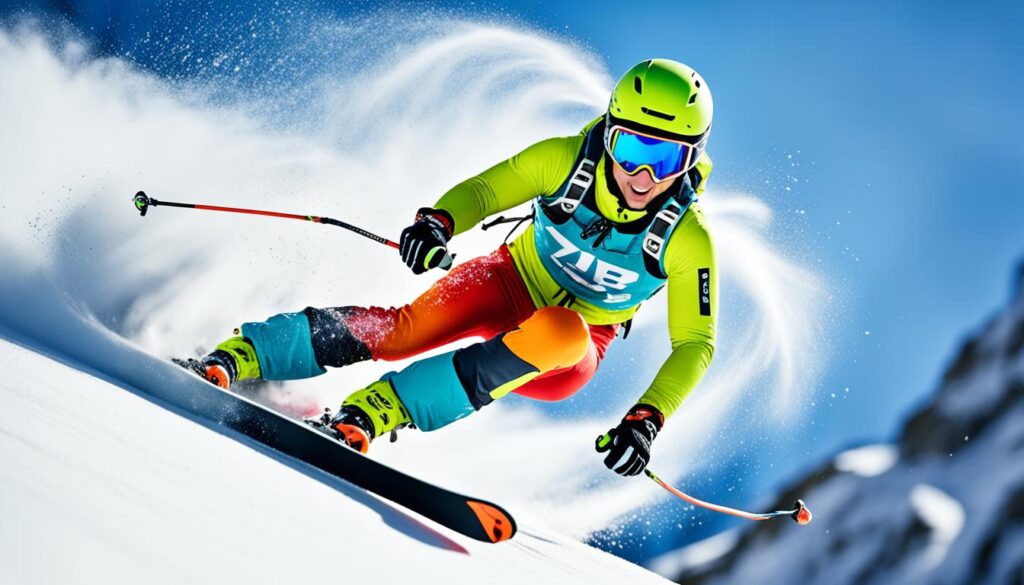
Note: Image above showcases a skier captured using fast shutter speed for a clear and sharp action shot.
Essential Tips for Ski Photography Composition
Composition is a crucial element in ski photography, as it determines the overall visual impact of your images. When composing your shots, it’s essential to pay careful attention to the background to ensure it enhances the subject and the action taking place. To create captivating ski photos, follow these essential tips for ski photography composition:
Avoid Cluttered Backgrounds
To ensure that the focus remains on the skier and the action, it’s important to avoid cluttered or distracting backgrounds. Elements such as rocks or trees can detract from the main subject and diminish the overall impact of your photos. Instead, aim to isolate your subject against a clean and uncluttered background. This will help draw the viewer’s attention to the skier and create a visually dynamic composition.
Utilize the Rule of Thirds
The rule of thirds is a well-known composition technique that can bring balance and interest to your ski photos. Imagine dividing your frame into nine equal sections by two horizontal and two vertical lines. By positioning the subject or key elements along these lines or at their intersection points, you can create a visually pleasing composition that feels harmonious and well-balanced.
Work with Leading Lines
Leading lines are elements within your photograph that guide the viewer’s eye toward the main subject. In ski photography, you can find leading lines in the ski tracks on the slopes, the curves of the snow, or even the skier’s body position. By incorporating leading lines into your composition, you can add depth and intrigue to your ski photos, enhancing the overall visual impact.
Remember, ski photography composition is a creative process that allows you to convey the excitement and beauty of skiing through your images. By paying attention to the background, utilizing composition techniques like the rule of thirds and leading lines, you can create visually stunning ski photos that captivate viewers and showcase your skills as a ski photographer.
Conclusion
Ski photography is an exhilarating and fulfilling endeavor for advanced skiers. By implementing the ski photography tips provided in this article, you can elevate your skills and capture breathtaking photos that showcase the excitement and beauty of the slopes. Experimentation with different angles and perspectives will bring a fresh perspective to your ski photography, allowing you to capture unique and captivating images.
Mastering exposure in snowy environments is crucial for achieving well-lit and vibrant ski photos. Understanding how to use the exposure compensation function will help you prevent underexposure and maintain the true colors of the snow. Don’t forget to harness the power of light and shadows to create dynamic and visually striking compositions.
Using fast shutter speeds will allow you to freeze the action and capture the skier’s movements with precision. By paying attention to composition and selecting clean backgrounds, you can ensure that the focus remains on the skier and the ski moment being captured.
With practice, creativity, and the application of these ski photography tips, you will be able to capture professional-quality ski photos that immortalize the thrill and joy of skiing. So, grab your camera and hit the slopes to start capturing those unforgettable ski moments today!
FAQ
What are some tips for advanced skiers to capture professional ski photos?
To capture professional ski photos, advanced skiers can experiment with different angles and perspectives, master exposure in snowy environments, utilize the power of light and shadows, use fast shutter speeds to freeze action, and pay attention to composition.
How can I get creative with angles and perspectives in ski photography?
To get creative with angles and perspectives in ski photography, try getting down low on the ground or finding high angles to add drama to your photos. By changing the perspective, you can capture unique and captivating images.
How can I master exposure in snowy environments?
To master exposure in snowy environments, learn how to use the exposure compensation function on your camera. Adjusting the exposure compensation dial to +1 or +2 can produce brighter images and prevent the snow from appearing gray and dreary.
How can I harness the power of light and shadows in ski photography?
To harness the power of light and shadows in ski photography, work with the position of the sun to create interesting light and shadow patterns on the snow. By keeping the sun to your side, the undulations and textures in the snow will be revealed, adding contrast and depth to your photos.
What is the key to capturing sharp and crisp action shots in ski photography?
The key to capturing sharp and crisp action shots in ski photography is to use fast shutter speeds. Sports mode or shutter priority mode can be utilized to set a fast shutter speed, generally around 1/1000 of a second or faster, to freeze the action and prevent motion blur.
What should I consider in terms of composition in ski photography?
In terms of composition in ski photography, pay attention to the background to ensure it enhances the overall image. Aim to isolate your subject against a clean, uncluttered background to help the viewer focus on the skier and the action taking place.
What are some essential tips for ski photography composition?
Some essential tips for ski photography composition include considering the rule of thirds, leading lines, and other composition techniques to create visually pleasing ski photos. Additionally, be mindful of the background to ensure it enhances the overall image.


